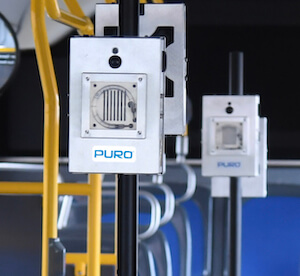Unlocking the Potential of Germicidal UV Lighting: Revolutionizing Sanitation with Commercial UV Light Sanitizers
In the relentless battle against invisible pathogens, the spotlight is increasingly turning to a powerful yet often overlooked weapon: germicidal UV lighting. From hospitals and laboratories to commercial spaces and public facilities, the application of germicidal UV lighting is transforming the landscape of sanitation practices, paving the way for safer, cleaner environments.
Understanding Germicidal UV Lighting
Germicidal UV lighting, also known as ultraviolet germicidal irradiation (UVGI), harnesses the power of ultraviolet (UV) light to eliminate harmful microorganisms. This technology works by disrupting the DNA of bacteria, viruses, and other pathogens, rendering them unable to replicate and thus neutralizing their ability to cause infections.
Unlike traditional cleaning methods that rely on chemicals or physical scrubbing, germicidal UV lighting offers a non-contact, chemical-free approach to disinfection. This makes it particularly appealing in environments where thorough sanitation is crucial, such as healthcare facilities, laboratories, and food processing plants.
The Rise of Commercial UV Light Sanitizers
In recent years, the commercial sector has embraced the use of UV light sanitizers as an integral part of their sanitation protocols. From restaurants and hotels to retail stores and offices, businesses are recognizing the value of germicidal UV lighting in enhancing cleanliness standards and instilling confidence in patrons.
Commercial UV light sanitizers offer several advantages over traditional cleaning methods. Firstly, they provide a rapid and efficient means of disinfection, capable of treating large areas and high-touch surfaces in a relatively short amount of time. This is particularly beneficial in fast-paced environments where downtime for cleaning is limited.
Secondly, UVGI technology offers a comprehensive approach to sanitation, reaching areas that may be difficult to clean manually or with traditional disinfectants. This includes air ducts, ventilation systems, and other hidden spaces where pathogens can linger undetected.
Applications in Healthcare Settings
The healthcare industry has long recognized the importance of stringent sanitation practices in preventing the spread of infections. Germicidal UV lighting has emerged as a valuable tool in the fight against healthcare-associated infections (HAIs), complementing existing cleaning protocols to create safer environments for patients and staff alike.
In hospitals and clinics, UV light sanitizers are used to disinfect patient rooms, operating theaters, and medical equipment. By targeting harmful pathogens such as MRSA, C. difficile, and influenza viruses, germicidal UV lighting helps reduce the risk of cross-contamination and infection transmission, ultimately improving patient outcomes.
Safety Considerations and Best Practices
While germicidal UV lighting offers numerous benefits in terms of disinfection efficacy and efficiency, it is essential to prioritize safety when implementing UVGI systems. UV radiation can pose risks to human health, including skin and eye damage, if proper precautions are not taken.
Commercial UV light sanitizers should be equipped with safety features such as motion sensors and automatic shutoff mechanisms to prevent accidental exposure to UV radiation. Additionally, personnel responsible for operating UVGI devices should receive adequate training on safety protocols and best practices.
Regular maintenance and inspection of UV light sanitizers are also critical to ensure optimal performance and compliance with safety standards. This includes replacing UV lamps as needed, cleaning the device's surfaces to remove dust and debris, and verifying that protective shielding is intact.

Looking Ahead: Innovations and Future Directions
As technology continues to evolve, so too does the potential of germicidal UV lighting in sanitation applications. Ongoing research and development efforts are focused on improving the efficiency, safety, and affordability of UVGI technology, opening up new possibilities for its use in various industries and settings.
From portable UV sanitization devices for personal use to advanced UVGI systems integrated into smart buildings, the future of germicidal UV lighting holds promise for revolutionizing how we approach cleanliness and infection control. As awareness of the importance of sanitation grows, so too will the demand for innovative solutions that prioritize safety, effectiveness, and sustainability.
Conclusion
Germicidal UV lighting represents a paradigm shift in the way we approach sanitation and infection control. From its widespread adoption in commercial settings to its indispensable role in healthcare facilities, UVGI technology is reshaping the way we safeguard against harmful pathogens. By harnessing the power of germicidal UV lighting, we can create safer, cleaner environments for everyone.
By using this site you agree to this Privacy Policy. Learn how to clear cookies here
1121회 로또복권 당첨번호 Jerald Aichelburg's Magical Bedtime Adventure EM-Eröffnung: Ein Fest des Fußballs und der Emotionen Zebra Movie We Live in Time OTET ఫలితాలు 2024 Exploring the Power and Versatility of Linear Actuators FOR SPANISH CITIZENS - NEW ZEALAND New Zealand Government ETA Visa - NZeTA Visitor Visa Online Application - Visa de Nueva Zelanda en línea - Visa oficial del gobierno de Nueva Zelanda - NZETA For AZERBAIJAN CITIZENS - NEW ZEALAND New Zealand Government ETA Visa - NZeTA Visitor Visa Online Application - New Zealand Visa Online - Yeni Zelandiyanın Rəsmi Hökuməti Viza - NZETA